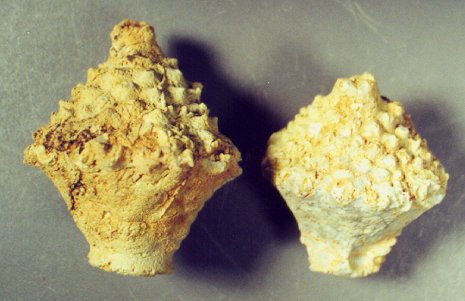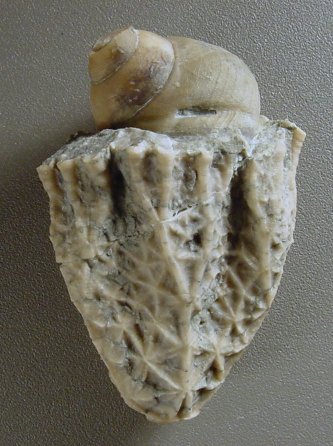
Photographs
Pentremites blastoid, the top or oral surface, shows the pentagonal (five-fold)-radial symmetry typical of most echinoderms
On the KPS field trip to Jackson County, KY, we first visited a small geology and fossil museum in Berea. Then, we explored some private property hillsides (with permission). We searched the Mississippian Pennington Formation and it yielded many brachiopods, Archimedes bryozoans, and of course, blastoids. The blastoids (Pentremites) are most often partly flattened, but can be quite large (over 1 inch). They are a pinkish/beige color.


Eretmocrinus crinoid
This field trip (which the KPS tries to take every other October) was led by Dr. David Meyer of the University of Cincinatti. We took a pontoon boat to otherwise inaccessable parts of Lake Cumberland (southern KY) to explore the Early Mississippian Fort Payne Formation. It is best to do this in the Fall when the lake level is between 693 and 698 feet. This exposes a lot of shoreline which is under water the rest of the year, yet still allows boat passage up the tributaries. Giant silicified crinoid stems (and sometimes calyxes) can be found on the flanks of bioherms, and in green shale lining the shore. On our last trip, 9 different types of crinoid calyx were found. On the last stop of the trip, we discovered a bioherm flank deposit of crinoids and collected about 100 calyxes! Dr. Meyer is going to do a population count at a future meeting. The crinoid calyxes (or parts of calyxes) we have found in just three trips are:
Mississippian crinoid stems, giant size


Glyptocrinus decadactylus crinoid with coprophagus Cyclonema snail attached
Photographs
This popular field trip explores the roadcuts on or near the "AA" highway east and west of Maysville. It starts in the highly fossiliferous Upper Ordovician Grant Lake (Maysvillian) and Bull Fork (Richmondian) formations. Maysville is deservedly world famous for its spectacular Upper Ordovician fossils. Here many beautifully preserved brachiopods are found. Also, perfectly enrolled Flexicalymene trilobites can be found (we found 8 on one trip). Many Glyptocrinus crinoids have been found also. Other fossils are bryozoans, snails, clams, horn corals, beautiful Tentaculites, cephalopods, and Rusophycus trilobite trails.
Of particular note are the many horn corals which have predatory borings in them. In addition, in upper Maysvillian rocks east and west of Maysville, several types of edrioasteroids have been found (some known from only a few specimens). Even an extremely rare cyclocystoid was found. Further east, we encounter Silurian dolostone (Bisher Formation) where many spectacular large trilobite burrows (Rusophycus) have been found. These burrows were likely made by the trilobite Trimerus. Even further east, we see the Mississippian Borden Formation and many beautiful reddish, partly pyritized fossils can be found.
Just west of Maysville, a crinoid pocket yielded many Glyptocrinus decadactylus calyces. The tegmen of the crinoid was preserved on a few of the specimens. This is the top part of the calyx (main body) and is composed of tiny plates and the anal opening. There were also many Cyclonema sp. snails in the vicinity of the crinoids. Several of the snails were still attached to the tegmen of the host crinoids. These snails were "coprophagus," which means they ate the waste products of the crinoids!

